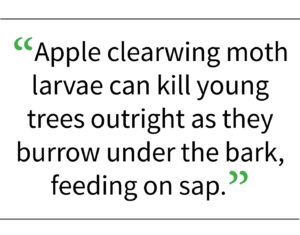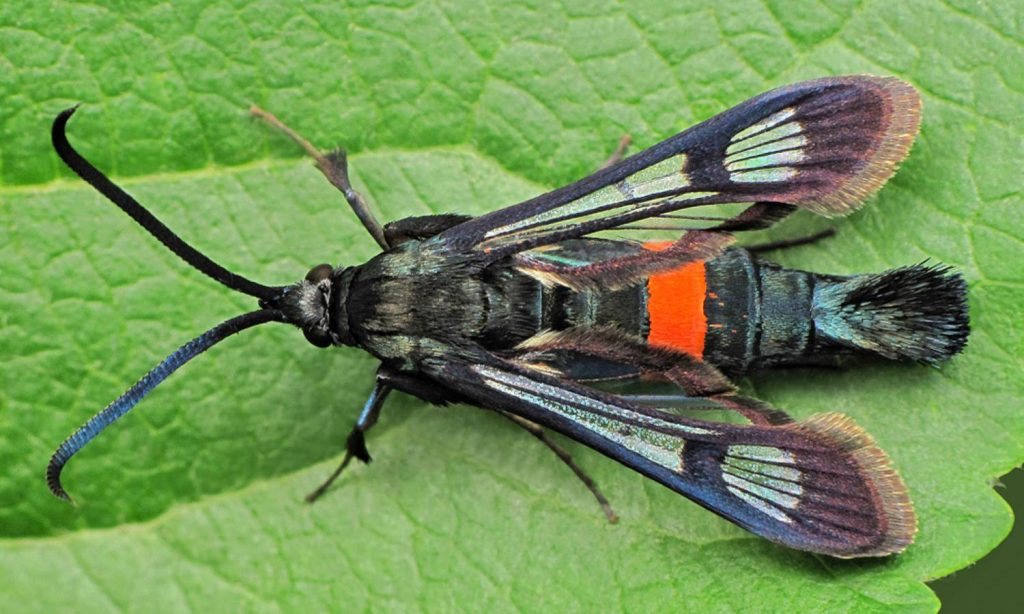Apple clearwing moth larvae can kill young trees outright as they burrow under the bark, feeding on sap
By Kate Russell

Kate Russell
Have you ever seen strange bits sticking out of your apple tree in spring? Or, moths fluttering around a tree on a summer afternoon? You might want to take a closer look. Those bits are often the discarded pupal casings from destructive moths. If they happen to be apple clearwing moths, your Morgan Hill trees may be in mortal danger.
Native to Europe, North Africa, and the Near East, apple clearwing moths were seen in Canada in 2005. Canadian entomologists now estimate that nearly all host trees in British Columbia are infested. By 2007, apple clearwing moths had made their way to Washington state. It’s only a matter of time until they reach Morgan Hill landscapes. And apple trees aren’t the only ones vulnerable to this pest. Almonds, apricots, cherries, crabapples, peaches, pears, plums, and quince may also be affected, along with hawthorn and mountain ash trees.
 Apple clearwing moth larvae can kill young trees outright as they burrow under the bark, feeding on sap. Older trees can be weakened to the point that they no long produce and may become dangerous.
Apple clearwing moth larvae can kill young trees outright as they burrow under the bark, feeding on sap. Older trees can be weakened to the point that they no long produce and may become dangerous.
These pests have a two-year lifecycle. Female moths feed on nectar in spring and summer. Then they lay up to 250 eggs singly in burr knots, grafts, pruning wounds, injured branch collars, and areas damaged by tree supports left in place for too long.
Apple clearwing moths, or red-belted moths, are easy to identify. They have narrow, bluish-black bodies, clear wings with a wingspan of three quarters of an inch to one inch, and what looks like a red belt. Larvae are a dirty white color, three-quarters of an inch long, with a reddish-brown head. Pupae are one-half inch long and pale yellowish-brown.
 In spring, check trees for signs of apple clearwing and other moth infestation. You may see sawdust or frass being pushed out of gallery holes. Check for tiny holes (half the diameter of a pencil lead) around the base of your trees while you’re at it.
In spring, check trees for signs of apple clearwing and other moth infestation. You may see sawdust or frass being pushed out of gallery holes. Check for tiny holes (half the diameter of a pencil lead) around the base of your trees while you’re at it.
Applications of cottonseed oil and Bacillus thuringiensis (Bt) have been shown to be helpful in reducing the number of adult moths emerging from cocoons. Apple clearwing moths are attracted to the same yellow pheromone traps that attract male peach tree borers. You can also make your own funnel trap and bait it with grape juice.
 Just remember, if you put out attractants, you will be ‘attracting’ moths to your garden. There are insecticides rated for use against apple clearwing moths, but they have their own drawbacks. Only do these things if you need to. And make sure your pruning cuts are clean and flat and that you do not damage any branch collars.
Just remember, if you put out attractants, you will be ‘attracting’ moths to your garden. There are insecticides rated for use against apple clearwing moths, but they have their own drawbacks. Only do these things if you need to. And make sure your pruning cuts are clean and flat and that you do not damage any branch collars.
If you believe your trees have become infested with apple clearwing moths, contact your local Master Gardeners right away. And try to capture a specimen. Together, we can slow the spread of this new pest and protect our fruit and nut trees.







